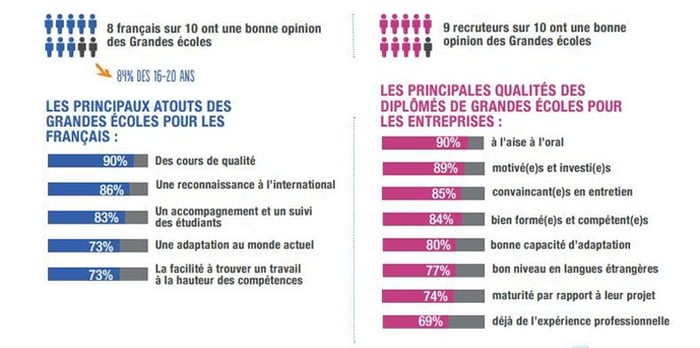« If you can be first, if you can't create a new niche in which you can be first ! " said the great Marketing expert Al Ries.
Today, the rankings of higher education institutions have multiplied. No school, no matter how specialized, can escape them.
However, there are almost no surprises each year as to the top of these rankings.- Polytechnique, Centrale, Les Mines, hold the top spots for engineering schools.
- HEC, ESSEC, ESCP, EM Lyon and EDHEC share the podium of business schools.
- Paul Bocuse and Ferrandi Paris lead in culinary training.
While these schools pride themselves on being at the top, rankings (such as that of L'Etudiant) have imposed their standard of ratings, which has drastically reduced the visibility of institutions not belonging to this elite.
Thankfully, today the Inbound Marketing offers adapted solutions and you don't have to be a prestigious school anymore to put forward your know-how and be competitive.
As such, more and more schools wanting to develop their notoriety are investing in communication built around content.
For a higher education institution, it has become essential to offer quality content and to know how to put it forward, and in this way to be its own media.
1 - But by the way what is a Grande Ecole ?
Paradoxically, without even knowing how to answer this question, the general public has a good image of the Grandes Ecoles, saccording to a study conducted by TNS Sofres.
In 2016, to the question " do you think that a quality education is provided within the Grandes Ecoles ? " it answered favorably at 90%. The respondents are 86% to think that these institutions have international recognition and 83% say they offer good support for students.
When recruiters are surveyed, the statistics are even more optimistic. Ninety percent have a good opinion of these schools and think that students are well prepared for oral exams, 89 percent find them motivated and invested, and 85 percent find them convincing in interviews.

image: Le Figaro Etudiant
According to these figures the Grandes Ecoles could congratulate themselves on such results.
However, it turns out that the " general public " and HRDs have only a rough knowledge of the panel of major metropolitan schools.
In fact, with the exception of institutions with historical notoriety in their respective disciplines such as Sciences Po, Arts et Métiers, Polytechnique, Ferrandi or ENA, schools considered "secondary" in the rankings are often confused and unrecognized by students, parents and recruiters.
So, 49% of respondents believe, for example, that the main difference between schools and universities is the price of the education.
So if your institution is not listed in the rankings and has limited visibility, how can you combat these biases and inaccuracies ?Grandes Ecoles, natural producers of content
In order to gain visibility and be increasingly attractive, Grandes Ecoles are communicating via content, notably by creating MOOC (Massive Open Online Courses).
The forerunners in this area were Telecom Bretagne and Institut Mines-Télécom, launching in September 2012 ItyPA (" Internet , it's all there to learn ").
Other engineering schools have also taken the step of these online trainings : the Ecole Centrale de Lille started in 2012 a training on project management. The ENS Ulm states about its MOOCs that they are "very interactive, concern both the sciences and the humanities and thus participate in the dissemination of knowledge in all fields. "

By investing heavily in these often free and content-rich courses, schools and universities are significantly increasing their reputation and prestige. This initiative allows them to make themselves known and attract the best students in a globalized educational system.
Once it's possible to be attractive by creating high-value online courses, a gap can develop between institutions that focus their communication on a content strategy and those that don't.
Inbound Recruiting within reach of all higher education institutions
« Don't be afraid to be creative and try things in your marketing. " (Mike Volp)
While the Top 5 schools still overshadow the lower-ranked ones, it is no longer necessary to be a prestigious school for you to showcase your expertise and highlight the different courses.
The possibilities offered by digital, social networks, and content-strategies oriented Inbound make it possible to stand out from the crowd, in the same way that some startups are beating the (commercial) tar out of solidly established groups.
If your job is to highlight an institution's offering, Inbound Recruiting, i.e., Inbound Marketing for recruiting, can help you do this very effectively, thanks to 4 simple steps:
- To convey a positive image, it's best to be your own media. So create a clear medium that targets student-prospects and aggregates quality content.
- When it comes to communication, social networks are no longer an option but a necessity. By using them skillfully you will achieve better targeting. For example, HEC uses LinkedIn to relay entrepreneurship articles, Instagram to reveal the behind-the-scenes of the campus and on YouTube the institution has several channels in order to address all candidate persona.
- By addressing the right content to the right people and especially at the right time in their documentation process, your institution will have more opportunities to convert student-prospects into enrolled students.
- Inbound Marketing also allows you to learn how to nurture (i.e., to continuously feed them with relevant content) candidates to influence their choice and from then on fight the prejudices and inaccuracies rooted in the minds of the French about the Grandes Ecoles.
Grandes écoles rankings tend to highlight the TOP 5 and leave the other schools out. This discrepancy is accentuated by a relative lack of knowledge among the French of the Grandes Ecoles system.
Thus, to differentiate themselves, some institutions shine by communicating on content creation.
Thanks to Inbound Marketing it is no longer necessary today to be in pole position in the rankings to enhance the value of one's training and attract the best students.







